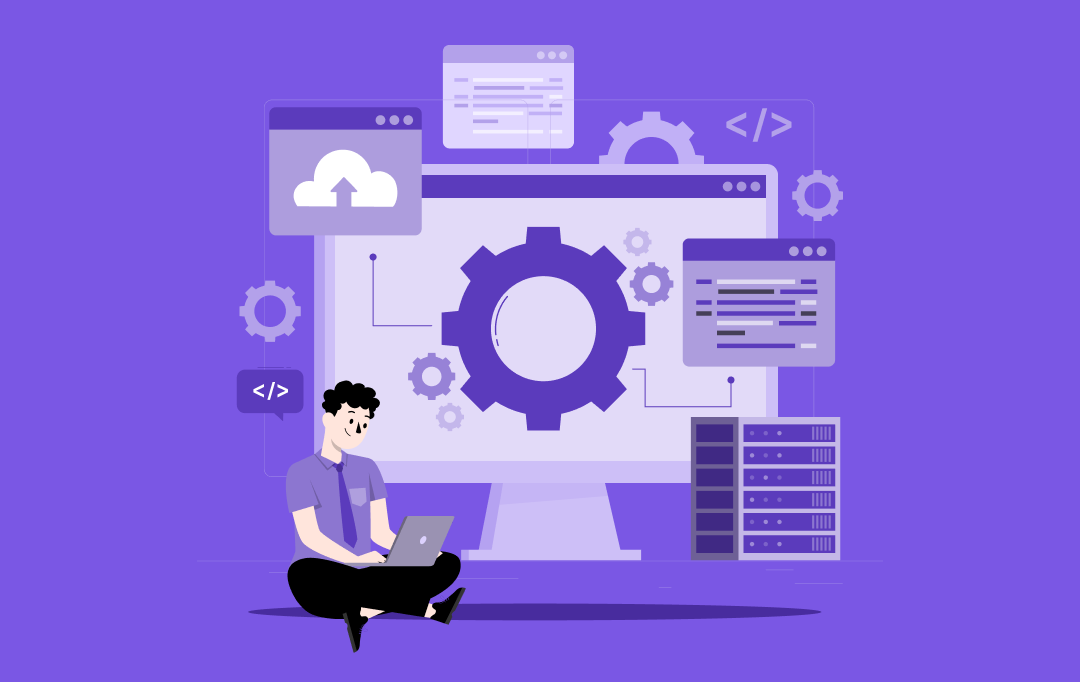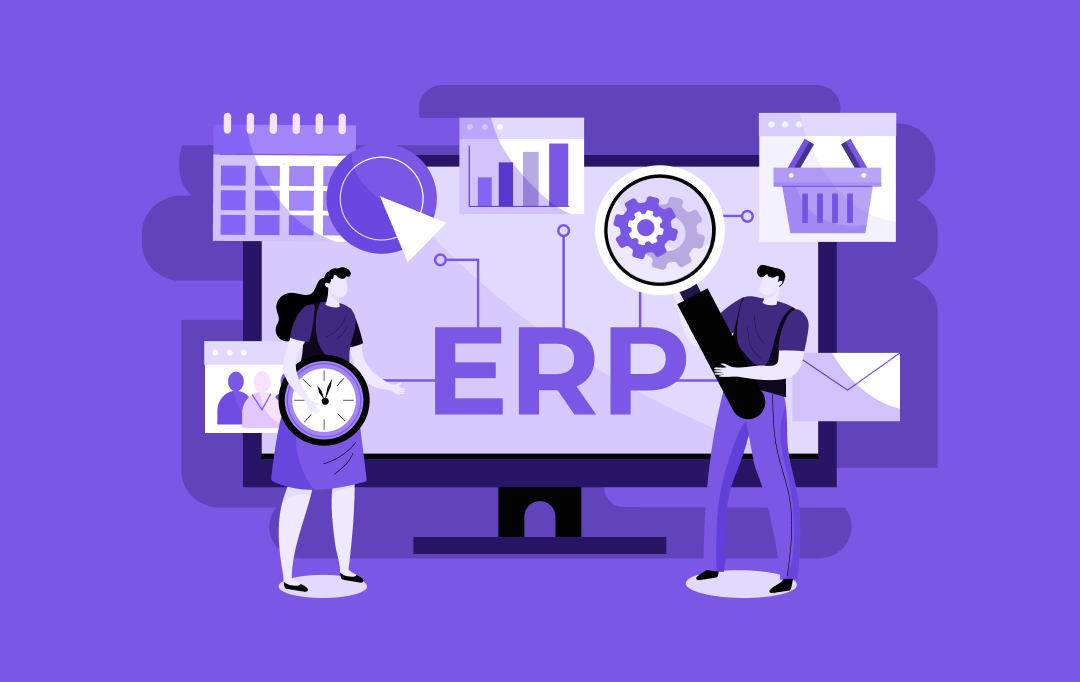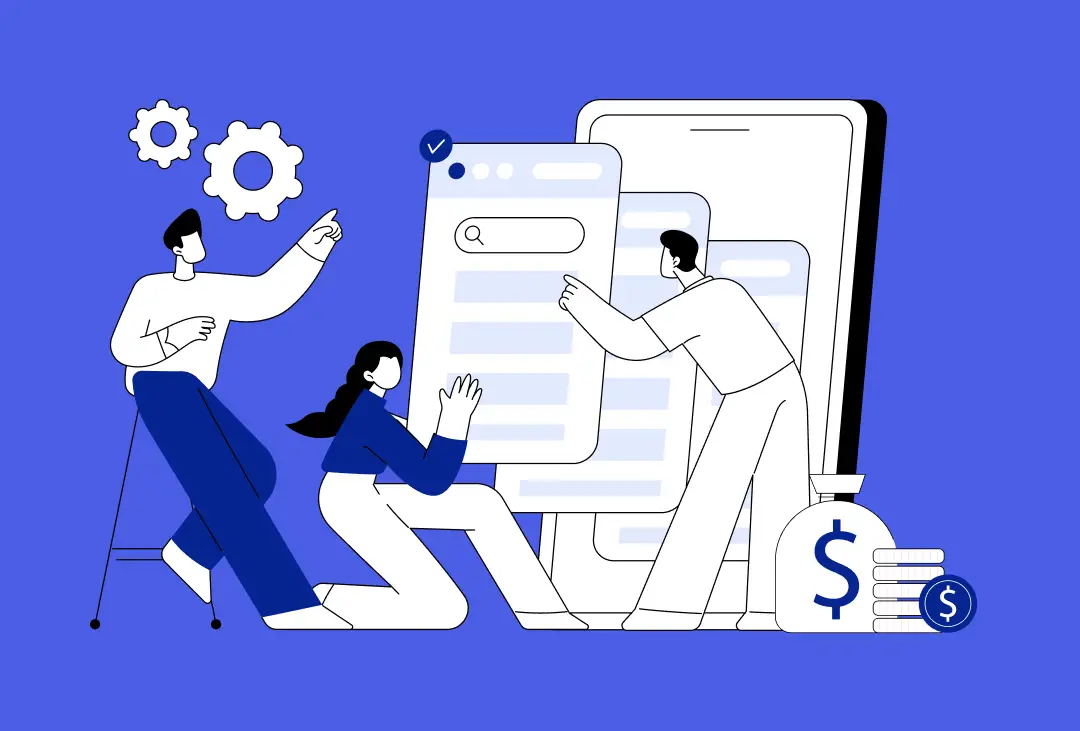Customer expectations have never been higher. They want instant support, seamless interactions, and personalized engagement across every touchpoint, whether it’s a website, mobile app, social media, or in-person visit. Yet, many businesses still struggle to deliver a unified experience. The problem isn’t a lack of effort; it’s the disconnect between systems, data silos, and outdated processes that prevent companies from truly understanding and responding to their customers in real time.
This is where customer experience management software comes in. It acts as the central nervous system of customer engagement – bringing together data, automating responses, and enabling businesses to craft experiences that feel effortless and intuitive. Done right, it not only improves customer satisfaction but also drives revenue growth, retention, and brand loyalty.
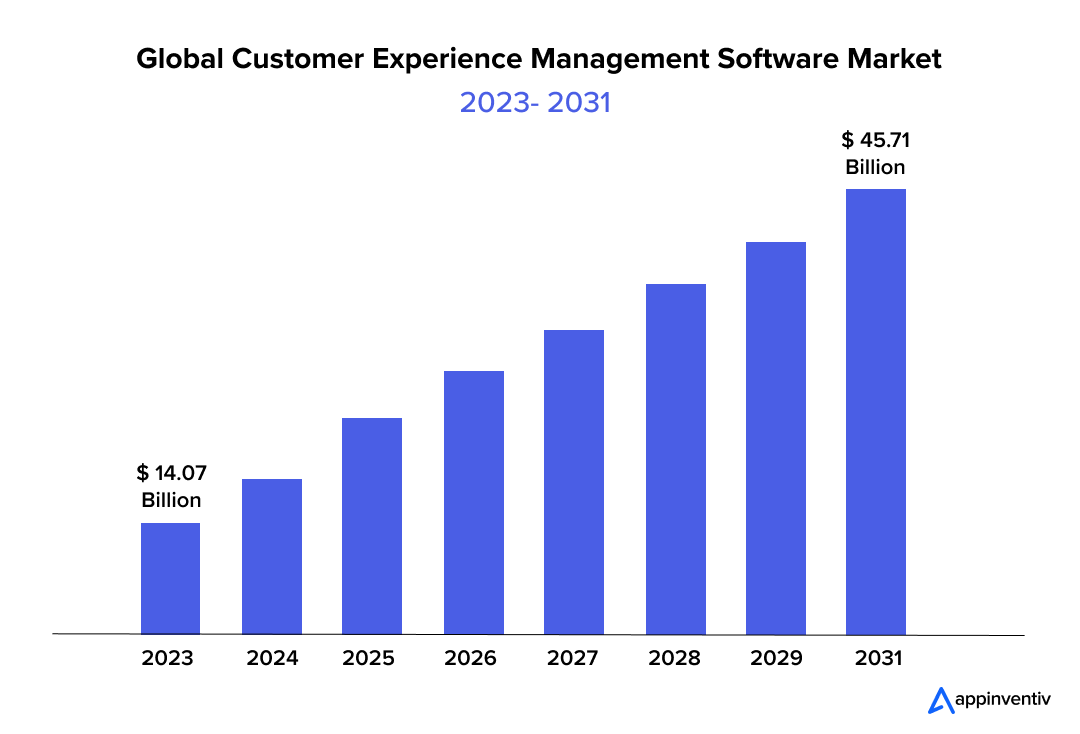
But here’s the challenge: customer experience management software development isn’t just about stitching together a few tools. It requires a deep understanding of customer behavior, scalable technology, and an architecture that can evolve alongside shifting market demands. Many companies set out to build CXM solutions only to realize halfway through that their approach lacks flexibility or fails to address critical experience gaps.
So, how do you shape your efforts in a future-ready customer experience software development that delivers real business impact? Let’s break it down.
Why CRMs Are No Longer Enough
For years, customer relationship management systems have been the backbone of customer interactions. They store contact details, track sales pipelines, and provide valuable data for businesses to manage relationships. Yet, despite their widespread adoption, CRMs often fall short in one crucial area – delivering seamless, real-time, and personalized customer experiences.
In today’s world, customer expectations have changed. They no longer engage with businesses through a single channel or follow a predictable sales cycle. A customer might discover a product through social media, compare options on a website, ask questions via live chat, and finalize the purchase in an app, all within a few hours. They expect businesses to remember their preferences, anticipate their needs, and provide proactive assistance across every interaction. Traditional CRMs weren’t built for this level of engagement.
Where CRMs Fall Short
- CRMs are designed for internal operations, not customer-centric experiences. They primarily help businesses track leads, manage contacts, and organize workflows. While this is useful for sales and service teams, it does little to improve the actual customer journey. A CRM might record that a customer had an issue last month, but it won’t ensure that their next experience is smoother.
- They focus on historical data, not real-time personalization. CRMs operate like digital filing cabinets, storing customer details and past interactions. However, they don’t dynamically respond to customer behavior at the moment. For instance, if a customer abandons their cart, a CRM alone won’t trigger a personalized offer or guide them back to complete the purchase.
- CRMs don’t unify customer interactions across multiple touchpoints. Customers switch between devices and channels – website, mobile apps, social media, emails, phone calls – expecting a consistent experience. Yet, most CRMs treat these interactions as separate records rather than a continuous conversation. This results in fragmented experiences where customers have to repeat themselves, leading to frustration.
How CXM Bridges the Gap
This is where customer experience management applications come into play. Unlike CRMs, which focus on storing and managing customer data, CXM actively enhances and personalizes every interaction in real time.
- Predictive insights and automation: Customer experience management system doesn’t just collect data; it analyzes and acts on it. AI-powered algorithms can anticipate customer needs, suggest personalized recommendations, and trigger automated workflows that make interactions smoother.
- Omnichannel experience orchestration: Customer experience management solutions unify customer interactions across all touchpoints – whether it’s a chatbot, an email campaign, a call center, or an in-store visit. This ensures that customers don’t feel like they’re dealing with disconnected departments but rather a single, cohesive brand.
- Proactive engagement instead of reactive support: Instead of waiting for customers to reach out with issues, CXM platforms allow businesses to anticipate problems and address them proactively. Whether it’s a drop in engagement, a delayed delivery, or a billing issue, a customer experience management system ensures that companies take action before frustration sets in.
In a competitive market where businesses are judged by their ability to deliver effortless, personalized experiences, relying solely on a CRM is no longer enough. A robust AI-powered customer experience improvement software development transforms customer interactions into long-term relationships, helping businesses drive loyalty, retention, and revenue growth.
With the benefits of customer experience software development established, the next step is understanding what goes into the software development for customer experience. Let’s break it down.
Must-Have Features of Customer Experience Management Software Development
The efforts to build customer experience management software is all about integrating a comprehensive suite of features that not only track interactions but also enhance, personalize, and optimize customer experiences in real time. Unlike traditional customer management tools, a well-designed CXM platform anticipates customer needs, enables proactive engagement, and ensures every touchpoint feels connected and seamless.
Here’s an in-depth look at the key features that define how to develop customer experience management software.
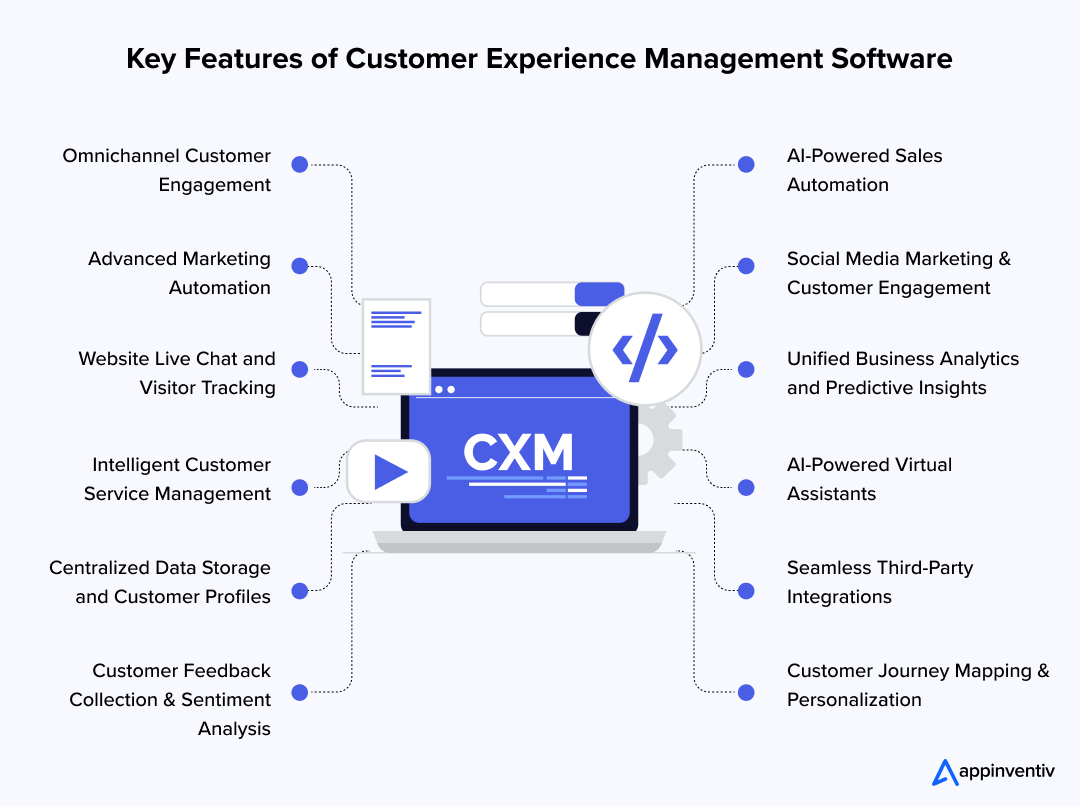
Omnichannel Customer Engagement
Customers today interact with brands through multiple channels – websites, mobile apps, social media, live chat, emails, phone calls, and even in-person visits. A strong CXM platform must unify these interactions to provide a seamless, omni-channel customer experience.
- Cross-channel consistency: Customers should be able to switch between channels without losing context. Whether they start a conversation via live chat and later continue via email or phone, their history should follow them.
- Personalized interactions: Data from all channels should be used to personalize engagements, ensuring customers feel understood at every step.
- Centralized customer profiles: A unified view of each customer’s interactions, preferences, and history enables brands to provide hyper-relevant and timely responses.
AI-Powered Sales Automation
Sales teams spend significant time on manual follow-ups, lead scoring, and tracking deal progress. AI-based customer experience improvement software development streamlines these processes, making sales more efficient and data-driven.
- Automated workflows: Set up workflows to trigger personalized follow-ups, reminders, and status updates based on customer behavior.
- Intelligent lead scoring: AI-based customer experience software development uses algorithms that can prioritize high-value leads by analyzing engagement patterns, past interactions, and intent signals.
- Task automation: Sales reps can automate routine activities like sending emails, updating CRM records, and scheduling calls, freeing up time for high-value interactions.
Also Read: How AI in CRM Transforms Customer Engagement
Advanced Marketing Automation
Customer experience app development goes beyond CRM-based marketing tools by offering real-time, data-driven campaign execution across channels. This ensures that marketing efforts are targeted, relevant, and results-driven.
- Hyper-segmented campaigns: Break audiences into micro-segments and run highly personalized campaigns based on browsing behavior, purchase history, and engagement levels.
- Multichannel execution: Manage and monitor email, social media, Google Ads, webinars, SMS, and survey campaigns from a single dashboard.
- AI-driven recommendations: Automate product recommendations, dynamic email content, and predictive engagement strategies to maximize conversions.
Social Media Marketing & Customer Engagement
Customers today expect brands to be responsive on social media. Experience management software development should integrate with major platforms (Facebook, Twitter, LinkedIn, Instagram, etc.) to help businesses manage interactions, track mentions, and enhance engagement.
- Sentiment analysis: AI-powered tools can analyze customer sentiment from posts, comments, and reviews, enabling businesses to respond proactively.
- Automated response workflows: Set up triggers for instant replies or escalate negative feedback to customer support teams before it escalates.
- Social commerce: Allow customers to purchase directly through social media channels while tracking interactions for personalized follow-ups.
Website Live Chat and Visitor Tracking
A great customer experience starts with real-time support. Live chat solutions, part of digital customer experience management software development powered by AI, help businesses capture leads, resolve inquiries, and convert visitors into paying customers.
- AI chatbots: Deploy AI-powered chatbots to handle common inquiries, qualify leads, and escalate complex issues to human agents when necessary.
- Behavior-based engagement: Track visitor actions on the website and trigger personalized messages based on browsing behavior (e.g., offering help when someone hesitates at checkout).
- Seamless agent transition: If a bot cannot resolve an issue, handoff should be instant and seamless to a human agent with full conversation history retained.
Unified Business Analytics and Predictive Insights
Retail customer experience management software development should account for real-time AI-based analytics that provide actionable insights into customer behavior, engagement trends, and overall business performance.
- Customer sentiment analysis: Understand how customers feel about products, services, and interactions through AI-driven text and voice analysis.
- Churn prediction models: Use AI to identify customers at risk of churning and trigger proactive retention strategies.
- Key performance indicators (KPIs) tracking: Track customer satisfaction (CSAT), Net Promoter Score (NPS), engagement rates, and conversion metrics in a unified dashboard.
Intelligent Customer Service Management
Customer support isn’t just about resolving tickets; it’s about delivering a consistent and proactive experience. Customer experience management solutions should empower service teams with contextual insights and AI-driven recommendations.
- AI-powered ticket routing: Automatically assign tickets to the right agents based on priority, complexity, or past customer interactions.
- Proactive issue resolution: Identify potential service issues before they arise and notify customers in advance.
- Social media integration: Convert customer complaints on Twitter, Facebook, or Instagram into support tickets and resolve them within the CXM dashboard.
AI-Powered Virtual Assistants
Introducing virtual assistants in the AI-based customer experience improvement software development process can help businesses automate customer interactions, analyze data in real time, and provide intelligent suggestions to teams.
- Predictive engagement: AI can anticipate when customers need assistance and offer proactive help before they ask.
- Voice and chatbot integration: AI-powered voice bots and chatbots can handle routine customer queries 24/7 while escalating complex issues to human representatives.
- Smart recommendations: AI suggests personalized offers, responses, and troubleshooting steps based on customer behavior.
Centralized Data Storage and Customer Profiles
A fragmented customer experience often stems from disconnected data sources. A customer experience management software should unify all customer touchpoints, transactions, and support history in a single, easily accessible location.
- 360-degree customer view: Store every interaction, purchase, support request, and engagement history in one place for seamless, personalized experiences.
- Data privacy and compliance: Ensure that all data is secure and compliant with regulations like GDPR and CCPA.
- Custom dashboards: Allow teams to access relevant customer data without sifting through multiple systems.
Seamless Third-Party Integrations
Customer experience app development efforts should integrate seamlessly with existing tools and platforms businesses already use. This ensures smooth workflows and eliminates data silos.
- CRM integration: Sync with popular CRM tools (Salesforce, HubSpot, Zoho, etc.) to ensure sales, marketing, and support teams work with up-to-date customer data.
- E-commerce platforms: Integrate with Shopify, Magento, WooCommerce, etc. to track customer journeys from browsing to purchase and post-sale engagement.
- ERP and supply chain tools: Sync with ERP systems to provide real-time updates on order processing, inventory, and delivery status.
Customer Feedback Collection & Sentiment Analysis
Understanding customer needs is at the core of a great customer experience management system. Collecting and analyzing feedback enables businesses to continuously improve experiences.
- Survey tools: Create customized surveys (NPS, CSAT, etc.) and analyze responses for improvement insights.
- Real-time feedback integration: Collect feedback from emails, chat interactions, and social media to get a holistic view of customer sentiment.
- Text analysis & AI-driven insights: Automatically extract key themes and emotions from customer feedback to improve decision-making.
Customer Journey Mapping & Personalization
Effective customer experience management solutions visualize the customer journey and use real-time data to offer hyper-personalized experiences.
- Touchpoint optimization: Identify friction points in the customer journey and implement AI-driven improvements.
- Real-time personalization: Offer dynamic content, personalized recommendations, and adaptive experiences based on customer behavior.
Feature-rich customer experience management software goes beyond basic customer management – it empowers businesses to create seamless, personalized, and proactive customer experiences. With the right tools in place, organizations can enhance engagement, reduce churn, and drive long-term customer loyalty.
Designing a CXM Software That Delivers Seamless and Personalized Experiences
Customer experience software development isn’t just about packing in features – it’s about designing an intuitive, scalable, and high-performing platform that enhances user interactions at every touchpoint. The software must be visually appealing, functionally seamless, and adaptable to evolving customer expectations.
Here are the core design aspects that shape an effective customer experience management software.

A User-Centric Interface for Effortless Navigation
What is common in all the great customer experience management examples is the fact that the platform should simplify complex customer interactions, not make them harder. The user interface must be clean, intuitive, and consistent, ensuring users can easily access key functionalities without unnecessary friction.
- Minimalist design with contextual guidance: Avoid clutter and provide clear navigation, tooltips, and intelligent suggestions to guide users.
- Role-based dashboards: Design personalized dashboards tailored for sales reps, marketers, customer support teams, and CX managers, ensuring they see only what’s relevant.
- Dark mode & accessibility options: Cater to different user preferences by incorporating color contrast adjustments, text resizing, and keyboard shortcuts.
Scalable and Modular Architecture for Future Growth
A customer experience management system must be built for scalability, ensuring it can handle increasing data loads and integrate new capabilities without performance degradation.
- Microservices-based architecture: Instead of a monolithic structure, opt for a modular design where each component (customer insights, engagement tracking, automation, analytics) operates independently but seamlessly.
- Cloud-native infrastructure: Ensure high availability and low latency by leveraging cloud-based storage, auto-scaling capabilities, and distributed computing.
- Headless CXM approach: Enable businesses to connect their CXM with multiple front-end interfaces, web, mobile, IoT devices, without disrupting backend functionalities.
AI-Driven Personalization and Automation
Experience management software development must be proactive, not reactive – leveraging AI to predict customer behavior, automate interactions, and offer hyper-personalized experiences.
- Real-time behavioral analytics: Capture user interactions across channels and adjust responses dynamically.
- AI-powered chatbots and voice assistants: Automate first-level interactions while ensuring smooth handoff to human agents when needed.
- Dynamic content delivery: Use AI to customize emails, recommendations, and website experiences based on real-time customer actions.
Omnichannel Data Synchronization for a Unified View
A great customer experience management software ensures that data flows seamlessly between sales, marketing, and support teams, eliminating silos and enabling a 360-degree customer view.
- Real-time data sync: Synchronize customer interactions across CRM, social media, email marketing, e-commerce, and service desks.
- Automated data cleansing: Implement AI-driven deduplication and standardization to maintain data accuracy.
- Custom APIs & integrations: Ensure smooth connectivity with third-party platforms like Salesforce, HubSpot, Zendesk, and payment gateways.
Security, Compliance, and Data Privacy by Design
Given the sensitive nature of customer data, the design part of customer experience software development must be approached with built-in security and compliance measures.
- Role-based access control: Restrict data access based on user roles to prevent unauthorized usage.
- Encryption & multi-factor authentication: Protect sensitive customer data with AES encryption, OAuth-based authentication, and biometric security.
- Compliance adherence: Ensure built-in support for GDPR, CCPA, HIPAA, and other regulatory standards to protect customer privacy.
Flexible Customization and No-Code/Low-Code Capabilities
Every business has unique customer experience needs. When you design and build customer experience management software, it should allow extensive customization without requiring deep technical expertise.
- Drag-and-drop workflow automation: Allow users to create custom workflows for lead nurturing, issue resolution, and campaign management without coding.
- Custom fields and data models: Adapt the CXM to specific industry needs by allowing businesses to define their own data structures.
- White-labeling options: Provide enterprises with the ability to rebrand the platform with their own logos, colors, and branding elements.
AI-Enhanced Insights and Visual Reporting
Raw data is useless without actionable insights. A customer experience management software should offer real-time analytics with AI-driven recommendations.
- Visual data storytelling: Replace static reports with interactive dashboards, heatmaps, and predictive trend analysis.
- Churn prediction models: Use AI to identify at-risk customers and suggest retention strategies.
- Automated reporting: Set up scheduled reports that deliver customer insights to stakeholders without manual intervention.
The design part of software development for customer experience ultimately determines its usability, efficiency, and long-term adaptability. By focusing on user experience, scalability, automation, security, and AI-driven insights, businesses can build a solution that not only manages customer interactions but enhances and personalizes them at scale.
Building a Scalable and Intelligent CXM Platform
Designing a customer experience management software is just the beginning. The real challenge lies in robust, scalable, and AI-driven customer experience improvement software development that integrates seamlessly with existing business systems while ensuring high performance and security.
This section outlines a step-by-step customer experience software development process that balances agility, scalability, and business alignment.
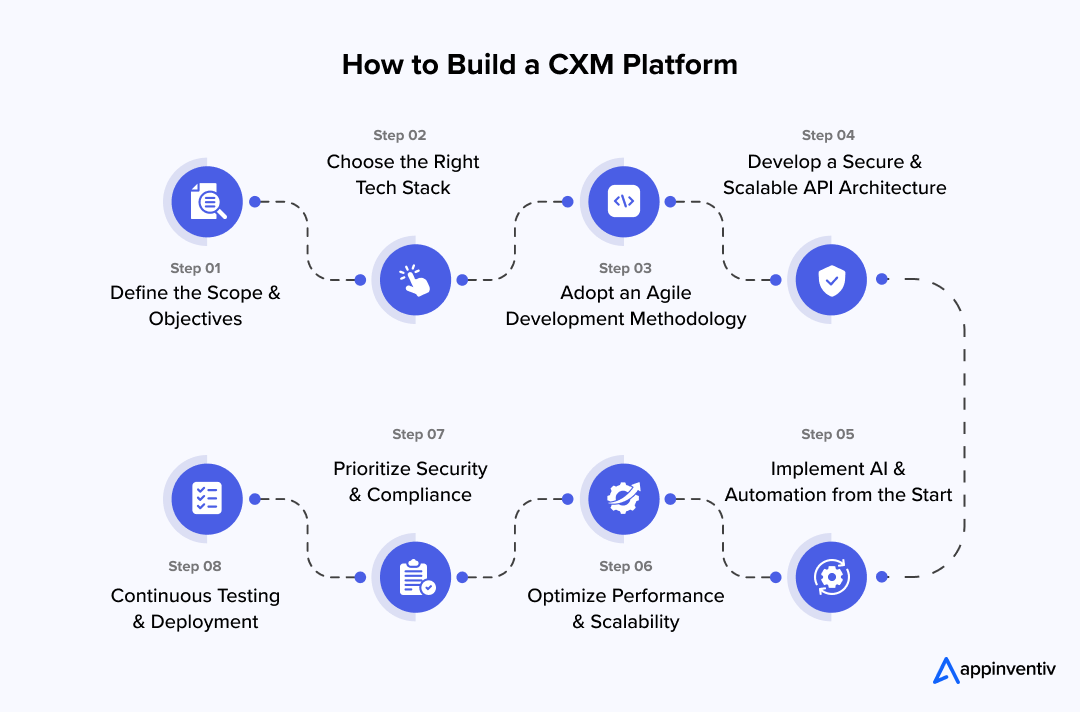
Define the Scope and Objectives
Before writing a single line of code, it’s crucial to establish what you want the answer for ‘what is customer experience management’ to be. Businesses must define:
- Target user roles: Will it serve sales teams, marketing departments, customer service agents, or all of them?
- Primary functionalities: Is the focus on omnichannel engagement, automation, analytics, or all three?
- Integration requirements: Which third-party platforms (CRM, ERP, social media, email marketing tools) should it connect with?
- Security and compliance needs: Will it need to adhere to GDPR, HIPAA, or other data protection laws?
A well-defined scope ensures alignment between business goals and technology implementation.
Choose the Right Tech Stack
The tech stack determines the performance, flexibility, and future scalability, along with the result of the entire customer experience software development process. Here’s a breakdown of key technologies:
- Frontend: React, Angular, or Vue.js for dynamic, fast-loading interfaces.
- Backend: Node.js, Python (Django/Flask), or Java (Spring Boot) for scalable API development.
- Database: PostgreSQL, MongoDB, or MySQL for structured and unstructured data management.
- Cloud Infrastructure: AWS, Azure, or Google Cloud for auto-scaling and global accessibility.
- AI & Automation: TensorFlow, OpenAI, and Rasa for chatbots, predictive analytics, and workflow automation.
- Security & Compliance: OAuth 2.0, JWT, and AES encryption for secure authentication and data protection.
Choosing a modular, cloud-native architecture ensures that the CXM software remains flexible, scalable, and future-proof.
Adopt an Agile Development Methodology
To ensure continuous improvement and faster time-to-market, an Agile development approach is ideal to get the most of the benefits of customer experience software development .
- Sprint Planning: Break down development into 2-week sprints with clear deliverables.
- MVP (Minimum Viable Product) Development: Build a functional core product with essential features (e.g., customer profiles, omnichannel engagement, and basic analytics).
- Iterative Enhancements: Add advanced capabilities like AI-driven insights, automation workflows, and predictive analytics based on user feedback.
- Continuous Testing: Implement automated unit testing, API testing, and UI testing to catch bugs early.
Agile allows faster adaptability based on real-time business and customer needs.
Develop a Secure and Scalable API Architecture
The end goal of software development for customer experience lies in the fact that it must integrate seamlessly with existing business tools. A well-designed API-driven architecture ensures this:
- RESTful & GraphQL APIs: Offer flexible, lightweight data exchange between systems.
- Webhooks & Event-Driven Architecture: Enable real-time updates across CRM, marketing tools, and support platforms.
- Third-Party Integration Capabilities: Allow businesses to connect their CXM with Salesforce, HubSpot, Zendesk, Stripe, Twilio, and more.
A strong API layer ensures the CXM solution can be easily adopted and customized for different industries.
Implement AI and Automation from the Start
AI-based customer experience improvement software development is more proactive, predictive, and efficient. Rather than adding AI as an afterthought, embed it into the development process:
- AI Chatbots & Virtual Assistants: Automate customer interactions using NLP-powered bots that handle common queries.
- Predictive Analytics: Use machine learning models to anticipate churn risk, customer sentiment, and buying intent.
- Automated Workflows: Enable businesses to trigger actions based on real-time customer behaviors (e.g., sending follow-up emails when a user abandons a cart).
A well-architected AI layer transforms CXM from a reactive tool to a proactive customer engagement engine.
Optimize Performance and Scalability
A CXM platform must handle high volumes of customer interactions without performance bottlenecks. Key optimization strategies include:
- Load Balancing & Auto-Scaling: Use Kubernetes and Docker to scale servers based on traffic demand.
- Edge Computing for Faster Data Processing: Process data closer to the user to reduce latency.
- Asynchronous Processing: Implement message queues (RabbitMQ, Kafka) to handle large-scale automation tasks efficiently.
Prioritize Security and Compliance
Since CXM platforms handle sensitive customer data, security must be embedded into every development phase.
- End-to-End Encryption: Protect customer interactions with TLS 1.3 and AES-256 encryption.
- Role-Based Access Controls (RBAC): Ensure only authorized personnel can access specific data.
- Data Residency Compliance: Store data in region-specific servers to comply with GDPR, CCPA, or HIPAA.
A secure-by-design approach ensures businesses earn customer trust while meeting legal obligations.
Continuous Testing and Deployment
To maintain software reliability, adopt a Continuous Integration/Continuous Deployment pipeline in your journey as you develop customer experience management software:
- Automated Testing: Unit tests, API tests, and UI tests to catch bugs early.
- Rolling Deployments: Gradual feature rollouts with rollback mechanisms.
- User Feedback Loops: Incorporate A/B testing and beta user feedback before launching new updates.
A well-structured CI/CD pipeline ensures faster innovation with minimal downtime.
Developing a CXM platform requires a strategic balance between scalability, automation, security, and user experience.
By following an agile, AI-powered, and API-driven approach, businesses can guarantee high returns as they invest in software development for customer experience. The result? A CXM solution that delivers seamless, personalized, and data-driven customer experiences.
Customer Experience Management Software Development Cost Breakdown
Building a customer experience management software involves several cost factors, ranging from development complexity to infrastructure and maintenance. While the total investment varies based on feature depth, integrations, AI capabilities, and scalability requirements, below is a breakdown of cost estimates based on different development scopes.
1. Basic CXM Platform ($40,000 – $100,000)
A lightweight solution designed for small to mid-sized businesses that need basic customer interaction tracking and automation.
What’s included:
- Omnichannel engagement (email, live chat, social media)
- Basic CRM and ticketing system
- Standard API integrations (CRM, marketing tools)
- Basic reporting and analytics
Who needs it?
Startups and SMBs that want to improve customer interactions without heavy automation or deep analytics.
2. Mid-Range CXM Software ($100,000 – $250,000)
A more advanced solution with automation, analytics, and deeper customer insights, designed for growing businesses.
What’s included:
- AI-powered chatbots and workflow automation
- Integration with CRMs, ERP systems, and marketing tools
- Predictive analytics for customer behavior tracking
- Data encryption and role-based access control
- Custom branding and user interface
Who needs it?
Mid-sized companies that require automation and analytics to scale their customer engagement strategies.
3. Enterprise-Grade CXM Software ($250,000 – $1,000,000+)
A fully customized, AI-driven CXM platform with deep data intelligence, hyper-personalization, and enterprise-level security.
What’s included:
- Custom AI/ML models for predictive customer insights
- Automated marketing, sales, and support workflows
- Real-time data synchronization across multiple departments
- Multi-language, multi-time zone support for global operations
- Advanced data compliance (GDPR, HIPAA, CCPA)
- High availability and scalability with cloud-native architecture
Who needs it?
Large enterprises and corporations managing millions of customer interactions across multiple channels.
Hidden Costs to Consider
Beyond the initial development, several ongoing costs can impact the total cost of ownership:
- Cloud Hosting & Infrastructure: AWS, Azure, or Google Cloud ($5,000 – $20,000/month depending on scale).
- AI & Data Processing: Training and deploying AI models ($10,000+ per model).
- API Licensing & Integrations: Costs vary for third-party services like Salesforce, Twilio, and payment gateways.
- Security & Compliance: Regular audits, data encryption, and legal compliance costs.
- Maintenance & Updates: Bug fixes, feature enhancements, and security patches (~15-20% of the total development cost per year).
How to Lower CXM Development Costs?
Without Compromising Quality
While custom CXM solutions can be expensive, several strategies can reduce costs while maintaining high functionality:
1. Prioritize an MVP
Instead of building everything at once, start with the core functionalities and expand based on user feedback. This approach saves costs and shortens development time.
2. Use Pre-Built API Integrations
Rather than developing custom integrations from scratch, leverage existing APIs for CRM, marketing automation, and support platforms.
3. Choose a Scalable Cloud Architecture
Opt for serverless or containerized infrastructure (AWS Lambda, Kubernetes) to scale based on demand, reducing hosting costs.
4. Implement Open-Source Technologies
Using open-source AI frameworks, automation tools, and databases can significantly cut licensing costs.
5. Outsource Non-Core Development Tasks
Hiring an in-house team for every task can be costly. Outsourcing certain components (e.g., UI/UX design, chatbot development) can reduce expenses while maintaining quality.
6. Optimize for Low-Code/No-Code Enhancements
Allow non-technical users to modify workflows, automation, and reports without needing a developer, reducing long-term maintenance costs.
The cost of customer experience software development depends on scale, complexity, and long-term vision. While an enterprise-grade solution can be a million-dollar investment, a well-optimized development approach can significantly reduce costs without sacrificing quality.
Challenges in CXM Development – Lessons from Our Experience
Through our journey of building CXM platforms for businesses across industries in our role as a custom customer experience management software company, we’ve encountered a wide range of challenges, from fragmented data systems to AI personalization struggles. These roadblocks, if not addressed early, can lead to inefficiencies, security risks, and poor customer engagement.
Based on our experience, we’ve identified the most common challenges of customer experience management software development that businesses face. Below, we break down these challenges and the strategies we’ve successfully implemented to overcome them.
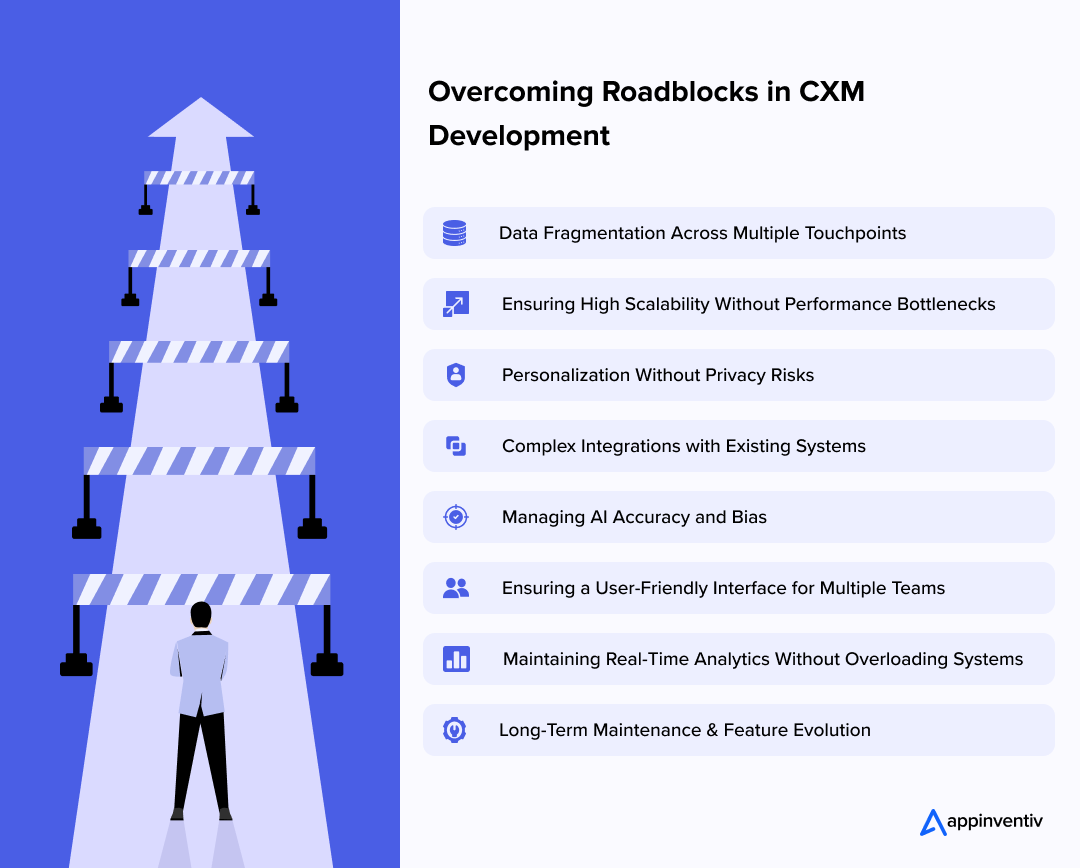
1. Data Fragmentation Across Multiple Touchpoints
Customers interact with businesses through emails, social media, live chat, websites, and call centers. Ensuring that all customer data flows into a unified system without duplication or inconsistencies is a major hurdle.
The solution:
- Implement real-time data synchronization across all channels.
- Use AI-driven data mapping to merge duplicate customer profiles.
- Opt for cloud-based architecture for centralized data access.
2. Ensuring High Scalability Without Performance Bottlenecks
A CXM platform must handle thousands (or even millions) of customer interactions daily. If not built with scalability in mind, system slowdowns and crashes can occur, affecting customer engagement.
The solution:
- Use microservices architecture to scale components independently.
- Implement load balancing and auto-scaling (AWS Auto Scaling, Kubernetes).
- Optimize databases with caching mechanisms (Redis, Memcached).
3. Personalization Without Privacy Risks
AI-driven personalization is key to delivering relevant experiences, but it comes with data privacy risks. Customers demand personalized interactions, but they also expect their data to be secure and not misused.
The solution:
- Implement strict data encryption (AES-256, SSL/TLS).
- Ensure GDPR, CCPA, and HIPAA compliance when handling personal data.
- Use privacy-first AI models that do not store sensitive customer data unnecessarily.
4. Complex Integrations with Existing Systems
CXM software needs to seamlessly connect with CRMs, ERPs, marketing automation tools, and customer support systems. Incompatibility issues can lead to delays, high integration costs, and broken workflows.
The solution:
- Use standardized APIs and middleware to simplify integrations.
- Choose a modular design that allows plug-and-play connections with third-party software.
- Offer custom API development kits for businesses with unique needs.
5. Managing AI Accuracy and Bias
Many CXM platforms rely on AI for chatbots, sentiment analysis, and predictive analytics. However, AI models can misinterpret customer intent, show biases, or fail in multilingual environments.
The solution:
- Train AI models on diverse datasets to minimize bias.
- Continuously refine AI using real-time customer feedback.
- Implement human-AI collaboration where AI escalates complex queries to live agents.
Also Read: An Explorative Guide to LLM Finetuning
6. Ensuring a User-Friendly Interface for Multiple Teams
A CXM platform is used by sales, marketing, customer support, and management. Designing an interface that serves all teams without clutter or complexity is challenging.
The solution:
- Offer role-based dashboards with team-specific insights.
- Allow users to customize their interface based on job functions.
- Focus on intuitive UX/UI design with easy navigation and automation shortcuts.
7. Maintaining Real-Time Analytics Without Overloading Systems
CXM software must analyze customer behavior, sentiment, and journey patterns in real-time. However, real-time data processing requires high computational power, which can increase costs and slow down the system.
The solution:
- Use edge computing to process data closer to the source.
- Implement event-driven architecture for real-time analytics.
- Optimize dashboards with cached data and predictive modeling to reduce processing loads.
8. Long-Term Maintenance & Feature Evolution
Customer expectations evolve, requiring frequent updates and feature enhancements. Without a solid maintenance strategy, the platform can become outdated quickly.
The solution:
- Adopt agile development for continuous improvements.
- Regularly update the CXM platform with AI enhancements and automation features.
- Implement modular coding to allow easy feature expansion.
Customer experience software development is a multi-faceted challenge that requires strategic planning, robust architecture, and continuous adaptation. Addressing these challenges early in development can help create a resilient, high-performance solution that drives long-term customer loyalty.
Understanding Customer Expectations From White-label CXM Platforms
In the rapidly evolving landscape of customer experience management, businesses are continually seeking platforms that not only meet but exceed customer expectations. For entrepreneurs developing white-label CXM solutions, aligning product offerings with these expectations is crucial for success. Drawing from industry insights and customer feedback, here are key elements that businesses typically desire in a CXM platform.
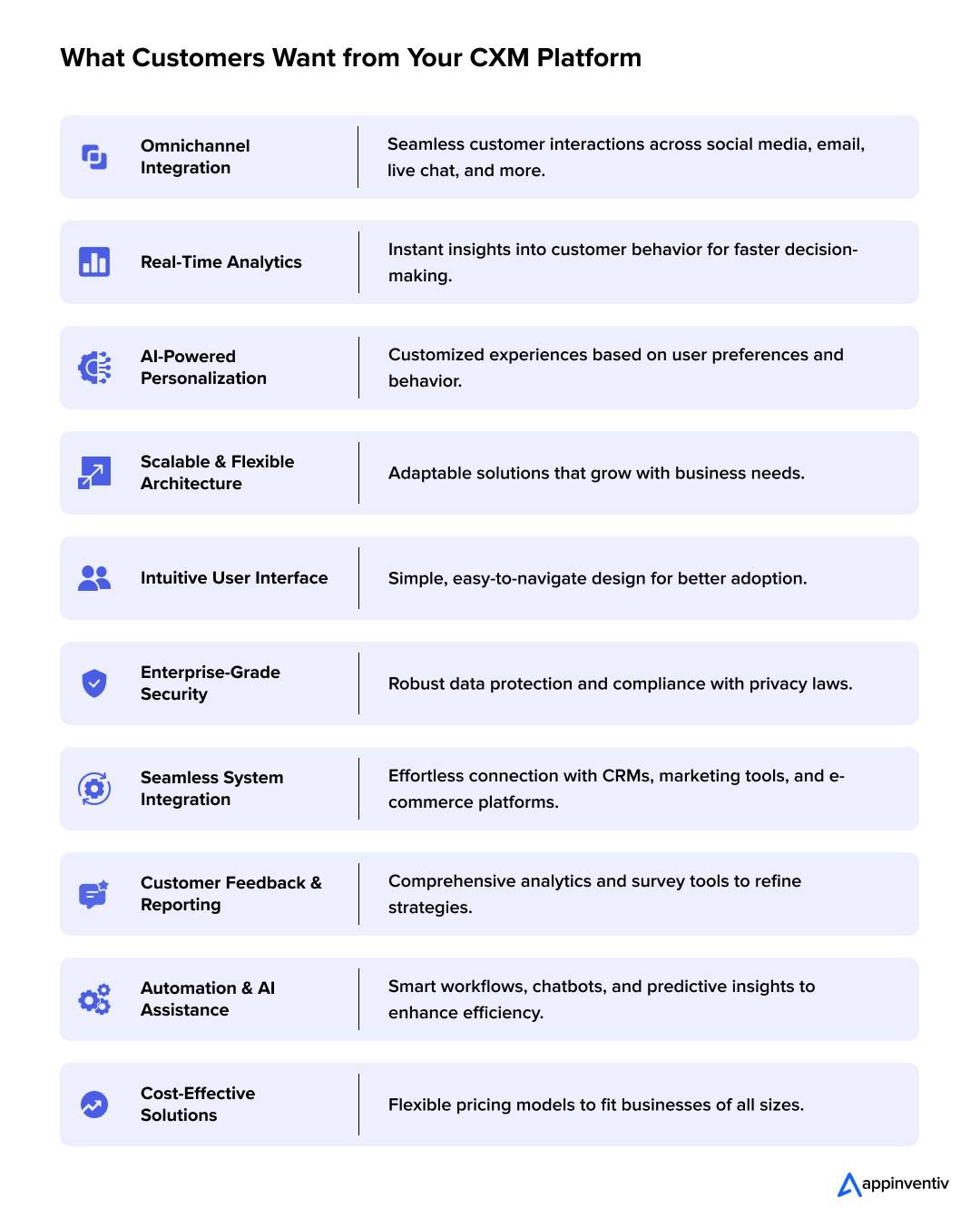
How Appinventiv Can Help You Build a Market-Leading CXM Platform
Building a CXM platform is more than just integrating multiple tools – it’s about creating a seamless, intelligent, and scalable system that enhances customer interactions at every touchpoint. At Appinventiv – a leading software development services provider, we’ve helped businesses across industries develop CXM solutions that improve customer engagement, optimize operations, and drive revenue growth.
AI-Powered Personalization for an E-Commerce Giant
A leading online retailer approached us to develop customer experience management software solutions that would provide hyper-personalized shopping experiences. Our team integrated AI-driven customer profiling, real-time behavioral tracking, and predictive analytics. The result? A 27% increase in repeat purchases and a 40% improvement in customer satisfaction scores within six months.
Unified Omnichannel CXM for a Telecom Provider
One of the California-based telecom companies struggled with fragmented customer interactions across call centers, chat, and email. We built a unified CXM system that centralized customer data, automated query resolution with AI, and integrated with existing CRMs. This led to a 35% reduction in customer complaints and a 20% boost in retention rates.
How We Deliver Market-Ready CXM Solutions
End-to-End Development Expertise
From ideation to deployment, we handle everything-UI/UX, backend architecture, AI integration, and cloud deployment.
Customizable & Scalable Solutions
We build CXM platforms tailored to your business model, ensuring flexibility for future growth.
AI-Driven Automation
Enhance customer engagement with AI-powered chatbots, predictive analytics, and workflow automation.
Seamless Third-Party Integrations
We connect your CXM with CRMs, marketing tools, social media, and analytics platforms for a unified ecosystem.
Enterprise-Grade Security & Compliance
As an enterprise software development services company, we adhere to industry standards like GDPR, HIPAA, and SOC 2, ensuring robust data protection and privacy.
Rapid Development with Agile Methodology
Our agile approach accelerates time-to-market without compromising quality.
Ongoing Support & Maintenance
Our customer experience software developers provide continuous updates, performance monitoring, and feature enhancements to keep your platform ahead of the curve.
FAQs
Q. How long does it take to develop a customer experience management software?
A. The timeline for customer experience management software development depends on factors like complexity, features, integrations, and customization requirements.
- MVP (Minimum Viable Product): 3–6 months
- Feature-rich CXM: 6–12 months
- Enterprise-grade solution: 12+ months
Leveraging agile development can accelerate the process, ensuring iterative releases and faster go-to-market.
Q. How much does it cost to build a customer experience management software?
A. CXM development costs vary based on features, tech stack, and scalability. Here’s a general breakdown:
- Basic CXM (Small businesses, essential features): $50,000 – $150,000
- Mid-level CXM (Advanced analytics, AI automation): $150,000 – $350,000
- Enterprise CXM (AI, omnichannel, deep integrations): $350,000+
Costs can be optimized by using pre-built APIs, cloud-based solutions, and phased development approaches.
Q. What are the top trends in the customer experience management software space?
A. The CXM landscape is evolving rapidly, with emerging technologies shaping customer interactions. Key trends include:
- AI & Automation: Predictive analytics, chatbots, and automated workflows enhance efficiency.
- Hyper-Personalization: Real-time data processing enables tailored customer experiences.
- Omnichannel Engagement: Seamless interactions across digital and physical touchpoints.
- Voice & Conversational AI: AI-powered voice assistants improving customer support.
- Customer Data Platforms (CDP): Unified customer data for deeper insights.
- Privacy & Compliance: Stronger focus on GDPR, CCPA, and AI ethics in CXM.
Product Development & Engineering
IT Managed & Outsourcing
Consulting Services
Data Services
Didn't find what you're looking for? Let us know your needs, and we'll tailor a solution just for you.




